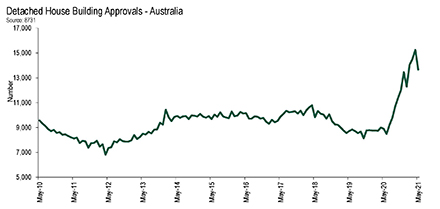Detached building approvals fell in May from the record level set in April but remain elevated, according to the Housing Industry Association. The Australian Bureau of Statistics this week released its monthly building approvals data for detached and multi-units data covering all states and territories. Source: Timberbiz
“Detached approvals are expected to remain elevated for several more months as approval authorities work through the remaining HomeBuilder projects,” HIA economist Angela Lillicrap said.
“April’s announcement of the extension of the time to build for HomeBuilder projects from six to 18 months, will see detached approvals elevated for longer. Builders are no longer rushing projects through the approvals process as this alleviates the pressure to meet the deadline,” Ms Lillicrap said.
“Detached housing approvals increased by 9.1% in the three months to May 2021, to be 63.1% higher than the same time last year.”
New Home Sales data, a leading indicator of building approvals, suggests that there is a significant number of new homes entering the pipeline post HomeBuilder.
“Confidence in the broader housing market is strong. Low interest rates will continue to drive demand for housing,” Ms Lillicrap said.
“The value of renovations activity approved is also elevated, up by 51.7% in the three months to May 2021 compared with the same time last year.
“Multi-unit approvals increased by 36.0% in the three months to May 2021 to be 25.7% higher than last year. This is the strongest quarterly result for this segment since 2018,” Ms Lillicrap said.
In seasonally adjusted terms, detached approvals saw the biggest increase in the three months to May 2021 compared with the same time last year in Western Australia (+148.0%). This was followed by South Australia (+83.3%), Queensland (+69.9%), Victoria (+48.9%) and New South Wales (+35.9%).
In original terms, detached house approvals increased in the Northern Territory by 141.4% during the three months to May 2021 compared with the same time last year. Tasmania (+49.5%) and the Australian Capital Territory (+22.6%) also increased during this period.






